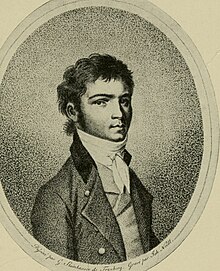Ludwig van Beethoven's Opus 1 is a set of three piano trios (written for piano, violin, and cello), first performed in 1795 in the house of Prince Lichnowsky, to whom they are dedicated.[1] The trios were published in 1795.
| Piano Trios | |
|---|---|
| by Ludwig van Beethoven | |
 The earliest known portrait of Beethoven; 1801 engraving by Johann Joseph Neidl after a now-lost portrait by Gandolph Ernst Stainhauser von Treuberg, ca. 1800 | |
| Key | |
| Opus | 1/1–3 |
| Dedication | Prince Lichnowsky |
| Performed | 1795: Vienna |
Despite the Op. 1 designation, these trios were not Beethoven's first published compositions;[2] this distinction belongs rather to his Dressler Variations for keyboard (WoO 63). Clearly he recognized the Op. 1 compositions as the earliest ones he had produced that were substantial enough (and marketable enough) to fill out a first major publication to introduce his style of writing to the musical public.
No. 1 in E-flat major
- Allegro (E-flat major), 4
4 - Adagio cantabile (A-flat major), 3
4 - Scherzo. Allegro assai (E-flat major, with trio in A-flat major), 3
4 - Finale. Presto (E-flat major), 2
4
The first movement opens with an ascending arpeggiated figure (a so-called Mannheim Rocket, like that opening the first movement of the composer's own Piano Sonata no 1, Opus 2 no 1),[3]
No. 2 in G major
No. 3 in C minor
- Allegro con brio (C minor), 3
4 - Andante cantabile con Variazioni (E-flat major), 2
4 - Minuetto. Quasi allegro (C minor, with a trio in C major), 3
4 - Finale. Prestissimo (C minor, concluding in C major), 2
2
Unlike the other piano trios in this opus, the third trio does not have a scherzo as its third movement but a minuet instead.
This third piano trio was later reworked by Beethoven into the C minor string quintet, Op. 104.[4]
References
External links
Wikiwand in your browser!
Seamless Wikipedia browsing. On steroids.
Every time you click a link to Wikipedia, Wiktionary or Wikiquote in your browser's search results, it will show the modern Wikiwand interface.
Wikiwand extension is a five stars, simple, with minimum permission required to keep your browsing private, safe and transparent.
